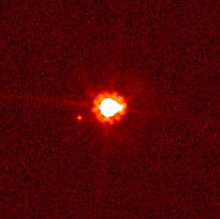ఎరిస్ (మరుగుజ్జు గ్రహం)
 ఎరిస్ (మధ్యలో) డిస్నోమియా (చంద్రుడు) (ఎడమ మధ్యన). హబుల్ టెలీస్కోపు. | |||||||
| Discovery | |||||||
|---|---|---|---|---|---|---|---|
| Discovered by: | M. E. Brown, C. A. Trujillo, D. L. Rabinowitz[1] | ||||||
| Discovery date: | October 21, 2003[1] | ||||||
| MPC designation: | 136199 Eris | ||||||
| Alternative names: | 2003 UB313[2] | ||||||
| Minor planet category: | dwarf planet TNO and SDO | ||||||
| కక్ష్యా లక్షణాలు | |||||||
| Epoch March 6, 2006 (JD 2453800.5)[3] | |||||||
| అపహేళి: | 97.56 AU 14.60×109km | ||||||
| పరిహేళి: | 37.77 AU 5.65×109 km | ||||||
| Semi-major axis: | 67.6681 AU 10.12×109 km | ||||||
| అసమకేంద్రత (Eccentricity): | 0.44177 | ||||||
| కక్ష్యా వ్యవధి: | 203,600 days 557 years | ||||||
| సగటు కక్ష్యా వేగం: | 3.436 km/s | ||||||
| మీన్ ఎనామలీ: | 197.63427° | ||||||
| వాలు: | 44.187° | ||||||
| Longitude of ascending node: | 35.8696° | ||||||
| Argument of perihelion: | 151.4305° | ||||||
| దీని ఉపగ్రహాలు: | 1 | ||||||
| భౌతిక లక్షణాలు | |||||||
| సగటు వ్యాసార్థం: | 1,300 +200 -100 km[4] | ||||||
| ద్రవ్యరాశి: | (1.67 ± 0.02)×1022 kg[5] | ||||||
| మధ్యరేఖ వద్ద ఉపరితల గురుత్వం: | ~0.8 m/s² | ||||||
| సైడిరియల్ రోజు: | > 8 h? | ||||||
| అల్బిడో: | 0.86 ± 0.07 | ||||||
| ఉపరితల ఉష్ణోగ్రత: (approx) |
| ||||||
| Apparent magnitude: | 18.7 | ||||||
| Absolute magnitude: | −1.12 ± 0.01 | ||||||
| Angular size: | 40 milli-arcsec[6] | ||||||
'ఎరిస్ (Eris, చిహ్నం: ![]() ;[7] ఉచ్ఛారణ 'ఎయిరిస్'),[8] మునుపు పేర్లు 136199 ఎరిస్, (2003) UB313. ఇది మరుగుజ్జు గ్రహాలలో అతిపెద్దదైనది. ప్లూటో కంటే పెద్దది. సూర్యుని చుట్టూ తిరిగే శరీరాలలో దేహరీత్యా తొమ్మిదవది. దీని వ్యాసము సుమారు 2,500 కి.మీ., ప్లూటో బరువుకన్నా 27% ఎక్కువ బరువు గలది .[5][9]
;[7] ఉచ్ఛారణ 'ఎయిరిస్'),[8] మునుపు పేర్లు 136199 ఎరిస్, (2003) UB313. ఇది మరుగుజ్జు గ్రహాలలో అతిపెద్దదైనది. ప్లూటో కంటే పెద్దది. సూర్యుని చుట్టూ తిరిగే శరీరాలలో దేహరీత్యా తొమ్మిదవది. దీని వ్యాసము సుమారు 2,500 కి.మీ., ప్లూటో బరువుకన్నా 27% ఎక్కువ బరువు గలది .[5][9]
Error: తప్పనిసరిగా మొదటి లైనులో ఓ బొమ్మని ఇవ్వాలి
2003 లో దీనిని ప్రథమంగా గమనించారు. కానీ 2005 లో గుర్తించారు. ఇది నెప్ట్యూన్ గ్రహానికి ఆవలివైపు గలదు. దీనికి ఒక సహజ సిద్ధ ఉపగ్రహం (చంద్రుడు) గలదు, దీని పేరు డిస్నోమియా. ఈ ఎరిస్, క్యూపర్ బెల్ట్కు ఆవల గల విసరబడ్డ డిస్క్లో గలదు. తోకచుక్కల ప్రాంతమైన ఈ విసరబడ్డ డిస్క్ లో ఎరిస్ ప్రదేశానికి మన సూర్యుడికి మధ్య దూరం 96.7 అంతరిక్ష మానాలు (AU).[10]
ఇది ప్లూటో కన్నా పెద్దదిగా వున్నందున NASA వారు దీనిని సౌరమండలము లోని పదవ గ్రహంగా అభివర్ణించారు.[11]
కనుగొనడం
[మార్చు]ఎరిస్ ను, మైక్ బ్రౌన్, ఛాద్ ట్రుజిల్లో,, డేవిడ్ రాబినోవిడ్జ్ ల జట్టు కలసి 2005 జనవరి 5 న కనుగొన్నారు.[10]

కక్ష్య
[మార్చు]
ఆకృతి, బరువు , ద్రవ్యరాశి
[మార్చు]ఎరిస్ వ్యాసం దాదాపు 2397 కి.మీ. 100 కి.మీ. తేడా, హబుల్ టెలీస్కోపు ద్వారా కనుగొనబడింది.[12]
సహజసిద్ధ ఉపగ్రహం
[మార్చు]
ఇవీ చూడండి
[మార్చు]మూలాలు
[మార్చు]- ↑ 1.0 1.1 Staff (మే 1, 2007). "Discovery Circumstances: Numbered Minor Planets". IAU: Minor Planet Center. Retrieved 2007-05-05.
- ↑ Staff (February 29, 2004). "Minor Planet Designations". IAU: Minor Planet Center. Retrieved 2007-05-05.
- ↑ Asteroid Observing Services
- ↑ John Stansberry; Will Grundy; Mike Brown; John Spencer; David Trilling; Dale Cruikshank; Jean-Luc Margot (2007). "Physical Properties of Kuiper Belt and Centaur Objects: Constraints from Spitzer Space Telescope" (PDF). University of Arizona, Lowell Observatory, California Institute of Technology, NASA Ames Research Center, Southwest Research Institute, Cornell University. Retrieved 2007-05-18.
- ↑ 5.0 5.1 Michael E. Brown; Emily L. Schaller (2007). "The Mass of Dwarf Planet Eris". Science. 316 (5831): 1585. doi:10.1126/science.1139415.
- ↑ ఉల్లేఖన లోపం: చెల్లని
<ref>ట్యాగు;natureఅనే పేరుగల ref లలో పాఠ్యమేమీ ఇవ్వలేదు - ↑ JPL/NASA (2015-04-22). "What is a Dwarf Planet?". Jet Propulsion Laboratory. Retrieved 2022-01-19.
- ↑ Dictionary.com Unabridged (v 1.1). Random House, Inc. http://dictionary.reference.com/browse/eris (accessed: November 12, 2007).
- ↑ "Dwarf Planet Outweighs Pluto". space.com. 2007. Retrieved 2007-06-14.
- ↑ 10.0 10.1 Mike Brown (2006). "The discovery of 2003 UB313 Eris, the largest known dwarf planet". Retrieved 2007-05-03.
- ↑ "The IAU draft definition of "planet" and "plutons"" (Press release). IAU. 2006-08-16. Archived from the original on 2006-08-20. Retrieved 2006-08-16.
- ↑ "Comment on the recent Hubble Space Telescope size measurement of 2003 UB313 by Brown et al". Max Planck Institute. 2006. Retrieved 2007-05-03.
బయటి లింకులు
[మార్చు]- Michael Brown's webpage about 2003 UB313
- Brown's webpage about 2003 UB313's satellite
- compiled list of data Archived 2005-12-10 at the Wayback Machine
- MPEC listing for 2003 UB313
- Java 3D orbit visualization Archived 2005-07-31 at the Wayback Machine
- http://www.spaceflightnow.com/news/n0509/09solarssytem/ Archived 2015-09-24 at the Wayback Machine
- Slacker Astronomy Interview With Co-Discoverer Trujillo
- Trans-Neptunian Object 2003 UB313 — IAU statement regarding the planetary status of 2003 UB313
- Simulation of 2003 UB313's orbit — 2003 UB313 is in a 17:5 resonance with Neptune
- Keck observatory page about the discovery of 2003 UB313's moon
- Caltech Press Release, 7/29/2005 "Planetary Scientists Discover Tenth Planet".
- http://www.spitzer.caltech.edu/Media/happenings/20050807/ Archived 2005-12-02 at the Wayback Machine
వీక్షణాలు
[మార్చు]- Keck Observatory, Hawaiʻi, US
- Palomar
- Gemini Archived 2011-02-23 at the Wayback Machine
- IRAM (Institut de Radio Astronomie Millimétrique (Institute for Millimetric Radio Astronomy)): French-German (Max-Planck Institut fur Radioastronomy, Bonn) and Spanish (where the 30 m telescope is situated) collaborative programme.
- HST

